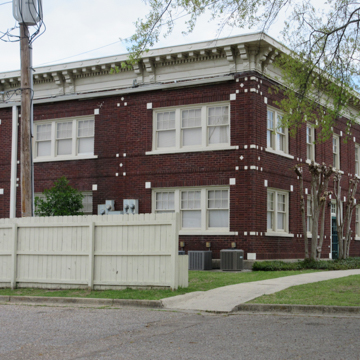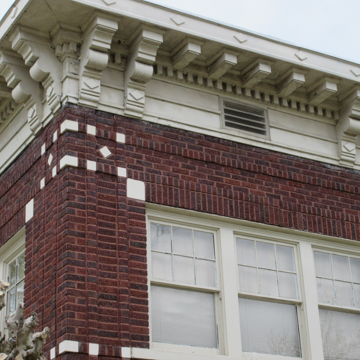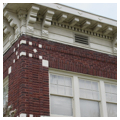This apartment building was constructed less than a handful of years after the chaos that accompanied the oil boom of 1921 when thousands of people poured into town so desperate for sleeping accommodations that, purportedly, even barber chairs rented for $2.00 a night. Builder James Saye Smith, previously in the construction business in Texas and Louisiana, hired a well-regarded Shreveport, Louisiana, architect to design this eclectic two-story, flat-roofed rectangular block containing twenty-four apartments. In a manner common to the Craftsman style, the surface bricks are laid in patterns, and inlaid limestone blocks above and between the groups of windows create a lively checkerboard effect. The deep, dentiled cornice, enriched by modillion blocks and supported by paired scrolled brackets, on the other hand, strikes a more formal classical note. At the building’s opening, the El Dorado Daily News hailed the complex as providing “ultra-modern luxurious accommodations.” Although this was an exaggeration with respect to size—the units were actually small efficiency apartments with Murphy beds in the living rooms—the apartments did offer maid service and ice delivery twice a day. An ingenious arrangement enabled ice to be delivered without disturbing the occupants: small paneled doors in the hallways opened into the rear upper compartments of the built-in iceboxes in each apartment. To aid ventilation in summertime, each apartment had two doors, one solid, one louvered. As planned, most early tenants were involved in various aspects of the oil business as geologists, oil lease brokers, petroleum engineers, and so forth, whose frequent travels among oil fields made larger accommodations unnecessary.
You are here
Historic El Dorado Apartments
If SAH Archipedia has been useful to you, please consider supporting it.
SAH Archipedia tells the story of the United States through its buildings, landscapes, and cities. This freely available resource empowers the public with authoritative knowledge that deepens their understanding and appreciation of the built environment. But the Society of Architectural Historians, which created SAH Archipedia with University of Virginia Press, needs your support to maintain the high-caliber research, writing, photography, cartography, editing, design, and programming that make SAH Archipedia a trusted online resource available to all who value the history of place, heritage tourism, and learning.







